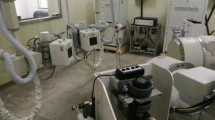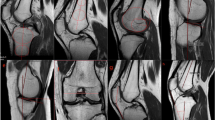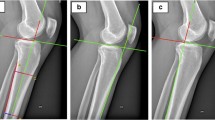Abstract
Purpose
Previous research has demonstrated that women have a higher risk of anterior cruciate ligament (ACL) injury than men. Tibiofemoral articular geometry may play a role in the occurrence of ACL tears. The purpose of this study was to analyze the gender-specific geometric characteristics differences in tibiofemoral morphology in ACL-deficient patients.
Methods
Medial tibial slope (MTS), lateral tibial slope (LTS), medial tibial plateau concavity, medial and lateral femoral condyle convexity, and lateral plateau convexity were analyzed in 276 patients with complete ACL injuries (138 females and 138 males). Two blinded observers measured the anatomical parameters of tibiofemoral geometry with use of multiplanar CT scans. Intra- and inter-rater reliabilities were assessed and comparisons between anatomic measures were made between male and female patients.
Results
The average ICC for all measurements was 0.90 (range 0.83–0.97) indicating good reliability. Male ACL injured patients demonstrated significantly greater LTS (10.5° ± 2.8) than female patients (9.6° ± 3.5°; p < 0.05). No gender difference in MTS was found (n.s.). Medial and lateral femoral condyle convexity and medial tibial plateau concavity were greater in males than females (all p < 0.05). Lateral tibial plateau convexity in females was higher than in males (p < 0.001). The medial and lateral compartments were found to be more incongruent in females than males (p < 0.01 and p < 0.001, respectively).
Conclusions
Female patients were noted to have more incongruent medial and lateral compartments than male patients. These gender-specific differences in joint morphology may contribute to graft tear risk and outcomes of ACL reconstruction; however, comparative clinical studies are needed to confirm this possibility.
Level of evidence
3.






Similar content being viewed by others
Abbreviations
- ACL:
-
Anterior cruciate ligament
- MTS:
-
Medial tibial slope
- LTS:
-
Lateral tibial slope
- CT:
-
Computerized tomography
- ICC:
-
Intra-class correlation
- MRI:
-
Magnetic resonance imaging
- IKDC:
-
International knee documentation committee
- PACS:
-
Picture archiving and communications system
- FOV:
-
Field of view
- DICOM:
-
Digital imaging and communications in medicine
- MPR:
-
Multi-planar reconstruction
- PTAA:
-
Proximal tibial anatomic axis
- MPL:
-
Medial tibial plateau length
- LPL:
-
Lateral tibial plateau length
- MCL:
-
Medial femoral condyle length
- LCL:
-
Lateral femoral condyle length
- MCR:
-
Medial compartment ratio
- LCR:
-
Lateral compartment ratio
- MCH:
-
Medial femoral condyle height
- LCH:
-
Lateral femoral condyle height
- MPH:
-
Medial tibial plateau height
- LPH:
-
Lateral tibial plateau height
- MCC:
-
Medial condyle convexity
- LCC:
-
Lateral condyle convexity
- MPC:
-
Medial plateau concavity
- LPC:
-
Lateral plateau convexity
- MC:
-
Medial femorotibial congruency
- LC:
-
Lateral femorotibial congruency
- SD:
-
Standard deviation
- mm:
-
Millimeters
- CI:
-
Confidence interval
References
Arendt EA, Agel J, Dick R (1999) Anterior cruciate ligament injury patterns among collegiate men and women. J Athl Train 34(2):86–92
Bowers AL, Spindler KP, McCarty EC, Arrigain S (2005) Height, weight, and BMI predict intra-articular injuries observed during ACL reconstruction: evaluation of 456 cases from a prospective ACL database. Clin J Sport Med 15(1):9–13
Bozkurt M, Unlu S, Cay N, Apaydin N, Dogan M (2014) The potential effect of anatomic relationship between the femur and the tibia on medial meniscus tears. Surg Radiol Anat 36:741–746
Brandon ML, Haynes PT, Bonamo JR, Flynn MI, Barrett GR, Sherman MF (2006) The association between posterior–inferior tibial slope and anterior cruciate ligament insufficiency. Arthroscopy 22(8):894–899
Brazier J, Migaud H, Gougeon F, Cotten A, Fontaine C, Duquennoy A (1996) Evaluation of methods for radiographic measurement of the tibial slope. A study of 83 healthy knees. Rev Chir Orthop Reparatrice Appar Mot 82(3):195–200
Chaudhari AM, Zelman EA, Flanigan DC, Kaeding CC, Nagaraja HN (2009) Anterior cruciate ligament-injured subjects have smaller anterior cruciate ligaments than matched controls: a magnetic resonance imaging study. Am J Sports Med 37(7):1282–1287
Dejour H, Bonnin M (1994) Tibial translation after anterior cruciate ligament rupture. Two radiological tests compared. J Bone Joint Surg Br 76(5):745–749
Ewald FC (1989) The Knee Society total knee arthroplasty roentgenographic evaluation and scoring system. Clin Orthop Relat Res (248):9–12
Genin P, Weill G, Julliard R (1993) The tibial slope. Proposal for a measurement method. J Radiol 74(1):27–33
Griffin LY, Agel J, Albohm MJ et al (2000) Noncontact anterior cruciate ligament injuries: risk factors and prevention strategies. J Am Acad Orthop Surg 8(3):141–150
Haddad B, Konan S, Mannan K, Scott G (2012) Evaluation of the posterior tibial slope on MR images in different population groups using the tibial proximal anatomical axis. Acta Orthop Belg 78(6):757–763
Harner CD, Paulos LE, Greenwald AE, Rosenberg TD, Cooley VC (1994) Detailed analysis of patients with bilateral anterior cruciate ligament injuries. Am J Sports Med 22(1):37–43
Hashemi J, Chandrashekar N, Gill B et al (2008) The geometry of the tibial plateau and its influence on the biomechanics of the tibiofemoral joint. J Bone Joint Surg Am 90(12):2724–2734
Hashemi J, Chandrashekar N, Mansouri H et al (2010) Shallow medial tibial plateau and steep medial and lateral tibial slopes: new risk factors for anterior cruciate ligament injuries. Am J Sports Med 38(1):54–62
Helito CP, Helito PV, Costa HP et al (2014) MRI evaluation of the anterolateral ligament of the knee: assessment in routine 1.5-T scans. Skelet Radiol 43(10):1421–1427
Hewett TE, Myer GD, Ford KR et al (2005) Biomechanical measures of neuromuscular control and valgus loading of the knee predict anterior cruciate ligament injury risk in female athletes: a prospective study. Am J Sports Med 33(4):492–501
Hohmann E, Bryant A, Reaburn P, Tetsworth K (2011) Is there a correlation between posterior tibial slope and non-contact anterior cruciate ligament injuries? Knee Surg Sports Traumatol Arthrosc 19(Suppl 1):S109-114
Hooper GJ (1986) Radiological assessment of anterior cruciate ligament deficiency. A new technique. J Bone Joint Surg Br 68(2):292–296
Jacobsen K (1976) Stress radiographical measurement of the anteroposterior, medial and lateral stability of the knee joint. Acta Orthop Scand 47(3):335 – 334
Kessler MA, Burkart A, Martinek V, Beer A, Imhoff AB (2003) Development of a 3-dimensional method to determine the tibial slope with multislice-CT. Z Orthop Ihre Grenzgeb 141(2):143–147
Landis JR, Koch GG (1977) The measurement of observer agreement for categorical data. Biometrics 33(1):159–174
LaPrade RF, Burnett QM 2nd (1994) Femoral intercondylar notch stenosis and correlation to anterior cruciate ligament injuries. A prospective study. Am J Sports Med 22(2):198–202 (discussion 203)
Lustig S, Scholes CJ, Costa AJ, Coolican MJ, Parker DA (2013) Different changes in slope between the medial and lateral tibial plateau after open-wedge high tibial osteotomy. Knee Surg Sports Traumatol Arthrosc 21(1):32–38
Lustig S, Scholes CJ, Leo SP, Coolican M, Parker DA (2013) Influence of soft tissues on the proximal bony tibial slope measured with two-dimensional MRI. Knee Surg Sports Traumatol Arthrosc 21(2):372–379
Matsuda S, Miura H, Nagamine R et al (1999) Posterior tibial slope in the normal and varus knee. Am J Knee Surg 12(3):165–168
McNair PJ, Wood GA, Marshall RN (1992) Stiffness of the hamstring muscles and its relationship to function in anterior cruciate ligament deficient individuals. Clin Biomech (Bristol Avon) 7(3):131–137
Meister K, Talley MC, Horodyski MB, Indelicato PA, Hartzel JS, Batts J (1998) Caudal slope of the tibia and its relationship to noncontact injuries to the ACL. Am J Knee Surg 11(4):217–219
Meric G, Gracitelli GC, Aram L, Swank M, Bugbee WD (2015) Tibial slope is highly variable in patients undergoing primary total knee arthroplasty: analysis of 13,546 computed tomography scans. J Arthroplasty 30(7):1228–1232
Musahl V, Ayeni OR, Citak M, Irrgang JJ, Pearle AD, Wickiewicz TL (2010) The influence of bony morphology on the magnitude of the pivot shift. Knee Surg Sports Traumatol Arthrosc 18(9):1232–1238
Nunley RM, Nam D, Johnson SR, Barnes CL (2014) Extreme variability in posterior slope of the proximal tibia: measurements on 2395 CT scans of patients undergoing UKA? J Arthroplasty 29(8):1677–1680
Puthumanapully PK, Harris SJ, Leong A, Cobb JP, Amis AA, Jeffers J (2014) A morphometric study of normal and varus knees. Knee Surg Sports Traumatol Arthrosc 22(12):2891–2899
Rahnemai-Azar AA, Abebe ES, Johnson P, Labrum J, Fu FH, Irrgang JJ, Samuelsson K, Musahl V (2017) Increased lateral tibial slope predicts high-grade rotatory knee laxity pre-operatively in ACL reconstruction. Knee Surg Sports Traumatol Arthrosc 25:1170–1176
Renstrom P, Ljungqvist A, Arendt E et al (2008) Non-contact ACL injuries in female athletes: an International Olympic Committee current concepts statement. Br J Sports Med 42(6):394–412
Siebold R, Axe J, Irrgang JJ, Li K, Tashman S, Fu FH (2010) A computerized analysis of femoral condyle radii in ACL intact and contralateral ACL reconstructed knees using 3D CT. Knee Surg Sports Traumatol Arthrosc 18(1):26–31
Snaebjörnsson T, Hamrin Senorski E, Sundemo D, Svantesson E, Westin O, Musahl V, Alentorn-Geli E, Samuelsson K (2017) Adolescents and female patients are at increased risk for contralateral anterior cruciate ligament reconstruction: a cohort study from the Swedish National Knee Ligament Register based on 17,682 patients. Knee Surg Sports Traumatol Arthrosc. doi:10.1007/s00167-017-4517-7
Song G, Zhang H, Wang Q, Zhang J, Li Y, Feng H (2016) Risk factors associated with grade 3 pivot shift after acute anterior cruciate ligament injuries. Am J Sports Med 44:362–369
Stijak L, Herzog RF, Schai P (2008) Is there an influence of the tibial slope of the lateral condyle on the ACL lesion? A case–control study. Knee Surg Sports Traumatol Arthrosc 16(2):112–117
Sturnick DR, Vacek PM, DeSarno MJ et al (2015) Combined anatomic factors predicting risk of anterior cruciate ligament injury for males and females. Am J Sports Med 43(4):839–847
Todd MS, Lalliss S, Garcia E, DeBerardino TM, Cameron KL (2010) The relationship between posterior tibial slope and anterior cruciate ligament injuries. Am J Sports Med 38(1):63–67
Uhorchak JM, Scoville CR, Williams GN, Arciero RA, St Pierre P, Taylor DC (2003) Risk factors associated with noncontact injury of the anterior cruciate ligament: a prospective four-year evaluation of 859 West Point cadets. Am J Sports Med 31(6):831–842
Utzschneider S, Goettinger M, Weber P et al (2011) Development and validation of a new method for the radiologic measurement of the tibial slope. Knee Surg Sports Traumatol Arthrosc 19(10):1643–1648
Vacek PM, Slauterbeck JR, Tourville TW et al (2016) Multivariate analysis of the risk factors for first-time noncontact ACL injury in high school and college athletes: a prospective cohort study with a nested, matched case–control analysis. Am J Sports Med 44(6):1492–1501
Wahl CJ, Westermann RW, Blaisdell GY, Cizik AM (2012) An association of lateral knee sagittal anatomic factors with non-contact ACL injury: sex or geometry? J Bone Joint Surg Am 94(3):217–226
Yoo JH, Chang CB, Shin KS, Seong SC, Kim TK (2008) Anatomical references to assess the posterior tibial slope in total knee arthroplasty: a comparison of 5 anatomical axes. J Arthroplasty 23(4):586–592
Zelisko JA, Noble HB, Porter M (1982) A comparison of men’s and women’s professional basketball injuries. Am J Sports Med 10(5):297–299
Zeng C, Cheng L, Wei J, Gao S, Yang T, Luo W, Li Y, Xu M, Lei G (2014) The influence of the tibial plateau slopes on injury of the anterior cruciate ligament: a meta-analysis. Knee Surg Sports Traumatol Arthrosc 22:53–65
Zhang Y, Wang J, Xiao J et al (2014) Measurement and comparison of tibial posterior slope angle in different methods based on three-dimensional reconstruction. Knee 21(3):694–698
Author information
Authors and Affiliations
Contributions
AS participated in the design of the study, acquisition and interpretation of the data. SS helped to evaluate the inter-observer reliability. RM helped to translate the manuscript in English and revising it critically for important intellectual content. SL have given final approval of the version to be published. PN have given final approval of the version to be published. ES have made substantial contribution to conception, design of the study and have given final approval of the version to be published.
Corresponding author
Ethics declarations
Funding
No external source of funding was used.
Conflict of interest
AS, SS, RM, SL, PN and ES: no competing interests.
Ethical approval
This study was approved by our institutional review board.
Informed consent
Patients gave informed consent that data would be published.
Rights and permissions
About this article
Cite this article
Schneider, A., Si-Mohamed, S., Magnussen, R.A. et al. Tibiofemoral joint congruence is lower in females with ACL injuries than males with ACL injuries. Knee Surg Sports Traumatol Arthrosc 26, 1375–1383 (2018). https://doi.org/10.1007/s00167-017-4756-7
Received:
Accepted:
Published:
Issue Date:
DOI: https://doi.org/10.1007/s00167-017-4756-7




